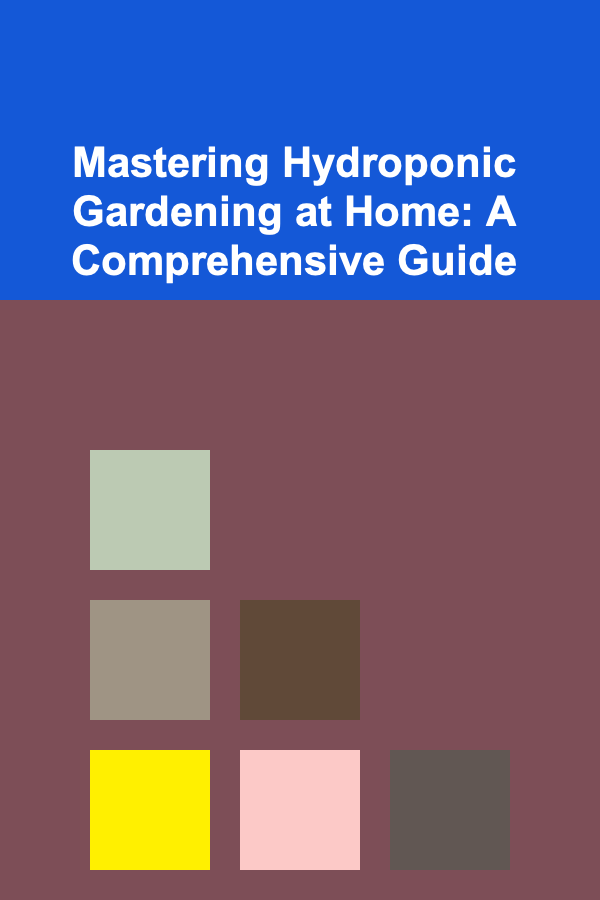
Mastering Hydroponic Gardening at Home: A Comprehensive Guide
ebook include PDF & Audio bundle (Micro Guide)
$12.99$7.99
Limited Time Offer! Order within the next:

Hydroponics, the art of growing plants without soil, is rapidly gaining popularity among home gardeners. This method offers numerous advantages, including faster growth rates, reduced water usage, and the ability to garden in limited spaces. This guide provides a deep dive into the world of hydroponics, covering everything from the basic principles to advanced techniques, enabling you to successfully cultivate your own thriving hydroponic garden at home.
Understanding the Fundamentals of Hydroponics
At its core, hydroponics involves providing plants with all the essential nutrients they need through a nutrient-rich water solution, delivered directly to the roots. By eliminating soil, hydroponics overcomes many of the limitations associated with traditional gardening. Plants expend less energy searching for nutrients and water, allowing them to focus on growth and fruit production.
Key Advantages of Hydroponic Gardening:
- Faster Growth: Plants typically grow faster in hydroponic systems due to the readily available nutrients.
- Reduced Water Usage: Hydroponic systems can use up to 90% less water than traditional soil-based gardening. Water is recirculated and reused, minimizing waste.
- Space Efficiency: Hydroponics is ideal for urban environments and indoor spaces, as it requires significantly less space than traditional gardening. Vertical systems can maximize space utilization.
- Pest and Disease Control: Hydroponic systems are less susceptible to soil-borne pests and diseases. The controlled environment allows for better monitoring and preventative measures.
- Year-Round Gardening: Indoor hydroponic systems enable year-round gardening, regardless of the external climate.
- Controlled Environment: You have more control over the growing environment, including temperature, humidity, and nutrient levels.
Essential Elements for Successful Hydroponics:
- Nutrients: Providing the correct balance of essential macro and micronutrients is crucial.
- Water: Using clean, pH-balanced water is essential for nutrient absorption.
- Light: Adequate light is necessary for photosynthesis. Supplemental lighting may be required for indoor systems.
- Oxygen: Roots need oxygen to function properly. Aeration of the nutrient solution is vital.
- Support: Plants need physical support to grow upright, especially as they mature and produce fruit.
Choosing the Right Hydroponic System for Your Needs
Several types of hydroponic systems cater to different space constraints, budgets, and levels of experience. Understanding the nuances of each system is essential for selecting the one that best suits your needs.
Wick System:
The simplest type of hydroponic system, the wick system, is passive and doesn't require any moving parts. Plants are placed in a growing medium (like perlite or coco coir), and a wick draws nutrient solution from a reservoir to the roots. This system is best suited for growing herbs and small plants that don't require a lot of water.
Pros:
- Inexpensive and easy to set up.
- No pumps or electricity required.
Cons:
- Not suitable for water-intensive plants.
- Nutrient distribution may be uneven.
Deep Water Culture (DWC):
In a DWC system, plant roots are suspended in a nutrient solution that is aerated with an air pump and air stone. The air stone provides the roots with the oxygen they need to thrive. DWC is a popular choice for growing leafy greens and herbs.
Pros:
- Simple to set up and maintain.
- Good for fast-growing plants.
Cons:
- Requires electricity for the air pump.
- Susceptible to temperature fluctuations.
Nutrient Film Technique (NFT):
In NFT systems, a thin film of nutrient solution flows continuously over the plant roots. The roots are suspended in a channel, allowing them to absorb nutrients and oxygen. NFT is commonly used for commercial hydroponics and is well-suited for growing lettuce, spinach, and other leafy greens.
Pros:
- Efficient nutrient delivery.
- High yields.
Cons:
- Requires careful monitoring of nutrient levels.
- Vulnerable to pump failures.
Ebb and Flow (Flood and Drain):
The ebb and flow system involves periodically flooding the growing tray with nutrient solution and then draining it back into the reservoir. This cycle provides the plants with nutrients and oxygen. Ebb and flow systems are versatile and can be used to grow a variety of plants, including vegetables, herbs, and flowers.
Pros:
- Versatile and adaptable.
- Easy to maintain.
Cons:
- Requires a timer and pump.
- Potential for salt buildup.
Drip System:
Drip systems deliver nutrient solution directly to the base of each plant through small tubes or emitters. This system is efficient and can be customized to meet the specific needs of different plants. Drip systems are often used for growing larger plants, such as tomatoes, peppers, and cucumbers.
Pros:
- Efficient water and nutrient delivery.
- Customizable for different plants.
Cons:
- Requires careful monitoring of emitters.
- Potential for clogging.
Aeroponics:
Aeroponics is an advanced hydroponic technique where plant roots are suspended in the air and periodically sprayed with nutrient solution. This system maximizes oxygen exposure and promotes rapid growth. Aeroponics is often used for research purposes and commercial production.
Pros:
- Maximum oxygen exposure.
- Very efficient water and nutrient usage.
Cons:
- More complex and expensive to set up.
- Highly susceptible to power outages.
Tip: For beginners, DWC and Wick systems are often the easiest and most affordable to start with. As you gain experience, you can explore more advanced systems like NFT and aeroponics.
Setting Up Your Hydroponic System
Once you've chosen a system, the next step is to set it up. Here's a general guide to setting up a basic hydroponic system:
- Gather Your Materials: Depending on the system you choose, you'll need a reservoir, growing container, growing medium, nutrient solution, air pump (for DWC), tubing, and other necessary components.
- Assemble the System: Follow the instructions for your chosen system to assemble the components. Ensure all connections are secure and leak-proof.
- Prepare the Nutrient Solution: Mix the nutrient solution according to the manufacturer's instructions. Use a pH meter to ensure the pH is within the optimal range (typically 5.5 to 6.5).
- Add the Growing Medium: Fill the growing container with the chosen growing medium (perlite, coco coir, rockwool, etc.).
- Transplant Seedlings: Carefully transplant the seedlings into the growing medium. Ensure the roots are well-covered and supported.
- Place Under Lights: Position the system under grow lights or in a location with ample sunlight.
- Monitor and Adjust: Regularly monitor the nutrient levels, pH, and water temperature. Adjust as needed to maintain optimal growing conditions.
Choosing the Right Growing Medium
While hydroponics eliminates the need for soil, plants still require a growing medium to provide support and retain moisture. Several options are available, each with its own advantages and disadvantages.
Rockwool:
Rockwool is a popular choice for hydroponics due to its excellent water retention and aeration properties. It is made from molten rock spun into fibers, providing a sterile and inert medium.
Pros:
- Excellent water retention and aeration.
- Sterile and inert.
Cons:
- Requires pre-soaking to adjust the pH.
- Can be dusty and irritating to handle.
Coco Coir:
Coco coir is a natural fiber derived from coconut husks. It is a sustainable and renewable resource that provides good water retention and aeration. Coco coir is often used as a substitute for peat moss.
Pros:
- Sustainable and renewable.
- Good water retention and aeration.
Cons:
- May contain salts that need to be flushed out.
- Can be expensive.
Perlite:
Perlite is a volcanic glass that is heated and expanded, creating a lightweight and porous material. It provides excellent aeration and drainage.
Pros:
- Excellent aeration and drainage.
- Lightweight and easy to handle.
Cons:
- Poor water retention.
- Can be dusty.
Vermiculite:
Vermiculite is a mineral that is heated and expanded, creating a lightweight and absorbent material. It provides good water retention and aeration.
Pros:
- Good water retention and aeration.
- Lightweight and easy to handle.
Cons:
- Can retain too much water, leading to root rot.
- Can be expensive.
Clay Pebbles (Hydroton):
Clay pebbles are baked clay balls that provide excellent aeration and drainage. They are inert and reusable.
Pros:
- Excellent aeration and drainage.
- Inert and reusable.
Cons:
- Poor water retention.
- Can be expensive.
Understanding Nutrient Solutions
The nutrient solution is the lifeline of your hydroponic garden. It provides plants with all the essential nutrients they need to grow and thrive. Choosing the right nutrient solution and maintaining the proper nutrient levels is crucial for success.
Essential Nutrients:
Plants require a balance of macro and micronutrients for optimal growth. The macronutrients include nitrogen (N), phosphorus (P), and potassium (K), which are essential for overall plant health, root development, and fruit production. The micronutrients include iron (Fe), manganese (Mn), zinc (Zn), copper (Cu), boron (B), and molybdenum (Mo), which are needed in smaller quantities but are equally important for various plant functions.
Choosing a Nutrient Solution:
Several commercially available nutrient solutions are specifically formulated for hydroponics. These solutions typically come in two or three parts, which need to be mixed according to the manufacturer's instructions. Choose a nutrient solution that is appropriate for the type of plants you are growing. Some solutions are formulated for vegetative growth, while others are formulated for flowering and fruiting.
Monitoring Nutrient Levels:
It's important to regularly monitor the nutrient levels in your hydroponic system. This can be done using an electrical conductivity (EC) meter or a total dissolved solids (TDS) meter. The EC or TDS reading indicates the concentration of dissolved salts in the nutrient solution. Adjust the nutrient levels as needed to maintain the optimal range for your plants. Also, regularly check the pH of your solution, keeping it in the 5.5 to 6.5 range for optimal nutrient uptake.
Warning: Over-fertilizing can be harmful to plants. Always follow the manufacturer's instructions when mixing nutrient solutions. Too much nutrient can burn the roots and stunt growth.
The Importance of Lighting
Light is essential for photosynthesis, the process by which plants convert light energy into chemical energy. Plants need adequate light to grow, flower, and produce fruit. Indoor hydroponic systems require artificial lighting to supplement or replace natural sunlight.
Types of Grow Lights:
- LED Grow Lights: LED (light-emitting diode) grow lights are energy-efficient and produce very little heat. They are available in a variety of spectrums to suit different stages of plant growth. LED lights are a popular choice for home hydroponic systems.
- Fluorescent Grow Lights: Fluorescent grow lights are less expensive than LED lights but are also less energy-efficient. They are suitable for growing seedlings and leafy greens.
- High-Intensity Discharge (HID) Grow Lights: HID grow lights, such as high-pressure sodium (HPS) and metal halide (MH) lights, are very powerful and produce a lot of light. They are often used for commercial hydroponics and for growing plants that require a lot of light, such as tomatoes and peppers. However, they also produce a lot of heat and require ventilation.
Light Spectrum:
Plants need different light spectrums for different stages of growth. Blue light is important for vegetative growth, while red light is important for flowering and fruiting. Some grow lights offer a full spectrum of light, which is suitable for all stages of plant growth.
Light Intensity and Duration:
The intensity and duration of light also play a crucial role in plant growth. The ideal light intensity and duration depend on the type of plants you are growing. Generally, seedlings require less light than mature plants. Most plants need at least 12 hours of light per day, but some may require up to 18 hours.
Managing Pests and Diseases
Hydroponic systems are generally less susceptible to pests and diseases than soil-based gardens, but problems can still occur. Monitoring your plants regularly and taking preventative measures can help to minimize the risk of infestations and infections.
Common Pests:
- Aphids: Small, soft-bodied insects that suck sap from plants.
- Spider Mites: Tiny pests that create webs on plants and suck sap.
- Whiteflies: Small, white insects that feed on plant sap.
- Fungus Gnats: Small, black flies that breed in moist growing media.
Common Diseases:
- Root Rot: A fungal disease that causes roots to decay.
- Damping Off: A fungal disease that affects seedlings.
- Powdery Mildew: A fungal disease that causes a white, powdery coating on leaves.
Preventative Measures:
- Maintain a Clean Environment: Keep your hydroponic system clean and free of debris.
- Use Sterile Growing Media: Use sterile growing media to prevent the introduction of pests and diseases.
- Monitor Plants Regularly: Inspect your plants regularly for signs of pests or diseases.
- Provide Good Air Circulation: Good air circulation helps to prevent fungal diseases.
- Use Organic Pest Control Methods: Use organic pest control methods, such as neem oil or insecticidal soap, to control pests.
Choosing the Right Plants for Hydroponics
While many plants can be grown hydroponically, some are more well-suited to this method than others. Leafy greens, herbs, and some fruiting vegetables are particularly successful in hydroponic systems.
Easy Plants to Grow Hydroponically:
- Lettuce: Grows quickly and easily in hydroponic systems.
- Spinach: Another fast-growing leafy green that thrives in hydroponics.
- Herbs: Basil, mint, chives, and oregano are all easy to grow hydroponically.
- Strawberries: Produce abundant fruit in hydroponic systems.
- Peppers: Can be grown successfully in larger hydroponic systems with adequate support.
- Tomatoes: Require more space and support but can yield impressive results in hydroponic setups.
Factors to Consider When Choosing Plants:
- Space Requirements: Choose plants that are appropriate for the size of your hydroponic system.
- Light Requirements: Select plants that have similar light requirements.
- Nutrient Requirements: Choose plants that have similar nutrient requirements.
- Support Requirements: Some plants, such as tomatoes and peppers, require support as they grow.
Troubleshooting Common Problems
Even with careful planning and execution, problems can arise in hydroponic gardening. Being able to identify and address these issues promptly is essential for maintaining a healthy and productive garden.
Yellowing Leaves:
Yellowing leaves can indicate a nutrient deficiency, pH imbalance, or overwatering. Check the pH and nutrient levels of your solution. Ensure proper drainage and avoid overwatering.
Stunted Growth:
Stunted growth can be caused by inadequate light, nutrient deficiencies, or pest infestations. Ensure plants are receiving adequate light and nutrients. Inspect plants for pests and take appropriate measures.
Root Rot:
Root rot is a fungal disease that causes roots to decay. This can be caused by poor aeration, overwatering, or high temperatures. Improve aeration by adding an air stone to your reservoir. Avoid overwatering and maintain a consistent water temperature.
Algae Growth:
Algae can grow in the nutrient solution if exposed to light. This can deplete nutrients and clog the system. Use an opaque reservoir to prevent light from reaching the nutrient solution. Clean the system regularly.
Advanced Techniques for Hydroponic Gardening
Once you've mastered the basics of hydroponic gardening, you can explore more advanced techniques to further optimize your yields and efficiency.
Vertical Hydroponics:
Vertical hydroponics maximizes space utilization by growing plants in vertical structures. This is ideal for urban environments and indoor spaces with limited square footage. Vertical systems can be constructed using PVC pipes, stacked containers, or specialized vertical hydroponic towers.
Aquaponics:
Aquaponics combines hydroponics with aquaculture, raising fish in a symbiotic relationship. Fish waste provides nutrients for the plants, and the plants filter the water for the fish. This creates a closed-loop system that is highly sustainable and efficient.
Automation:
Automating certain aspects of your hydroponic system can save time and effort. This can include automating watering, nutrient delivery, and lighting. Automated systems can be controlled using timers, sensors, and microcontrollers.
Conclusion
Hydroponic gardening offers a rewarding and efficient way to grow your own fresh produce at home. By understanding the fundamental principles, choosing the right system, and providing the necessary care and attention, you can create a thriving hydroponic garden that provides you with delicious and nutritious food year-round. Don't be afraid to experiment and learn as you go. The journey of mastering hydroponics is an ongoing process, and the rewards are well worth the effort.

How to Design a Statement Lighting Fixture for Your Dining Room
Read More
How To Master Face Rolling for Lymphatic Drainage
Read More
How to Organize Your Social Media Accounts Effectively
Read More
How to Sell Your Rare Vinyl Records Through Virtual Music Fairs: An Actionable Guide
Read More
How to Understand and Use Investment Risk Tolerance
Read More
How to Use Blockchain for Digital Art Ownership
Read MoreOther Products

How to Design a Statement Lighting Fixture for Your Dining Room
Read More
How To Master Face Rolling for Lymphatic Drainage
Read More
How to Organize Your Social Media Accounts Effectively
Read More
How to Sell Your Rare Vinyl Records Through Virtual Music Fairs: An Actionable Guide
Read More
How to Understand and Use Investment Risk Tolerance
Read More